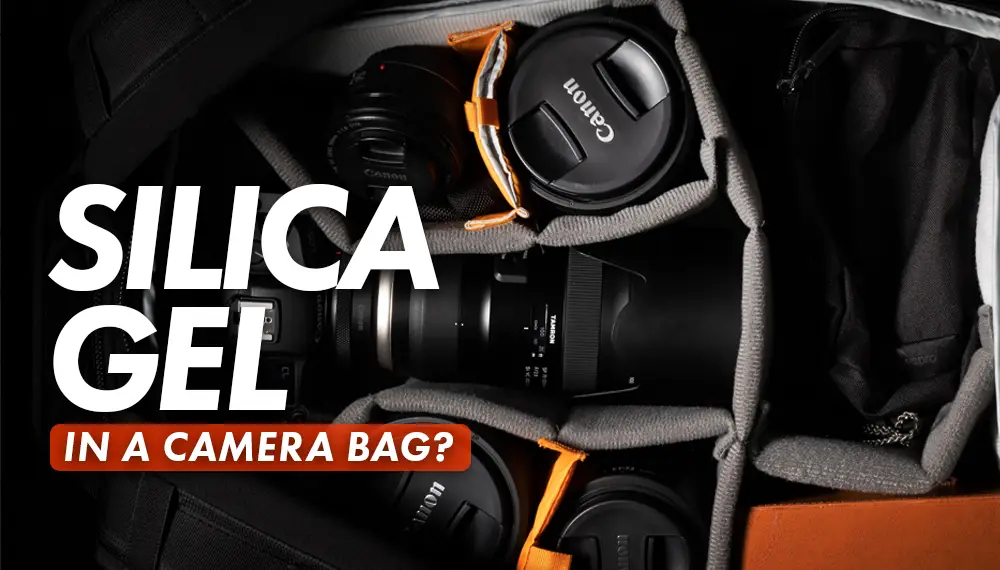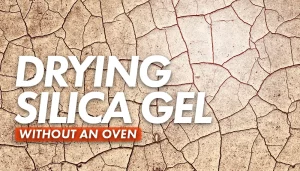Using Silica Gel in your camera bag can help protect your equipment from moisture and fungus if done right. If done incorrectly, it could slowly release moisture into the bag itself. In this article, we’re going to tell you when, how and why you should use Silica Gel in your camera bag to keep moisture, and fungus at bay when it’s humid. To get the most out of it though, you need to be aware of some peculiarities of Silica Gel, and we’re going to help you understand that.
We’ve written a lot about Silica Gel on this website. We’ve explained how we use it, how to recharge silica gel so that you can reuse it, and how to make the most of it in different scenarios, but in a camera bag, silica gel isn’t at its most efficient, or best use. Here are some tips on how to use silica gel in your camera bag:
Table of Contents
How Silica Gel Works
Silica Gel works by the process of adsorption. It is an inert, porous material with microscopic holes. When dry, the silica gel attracts moisture out of the air, and holds it in these microscopic channels within it. It is very effective at reducing humidity of an enclosed space. Silica gel can bring the humidity of an enclosed space down to 40% in a span of a few hours depending on how much you use, making it very efficient at its job. Once these pores are saturated, you can heat up silica gel to recharge it many, many times.
Silica Gel Needs an Enclosed Space
Though Silica Gel is effective at controlling humidity, it works best in an air-tight container. Any air leakage into the humidity controlled space will make the humidity change, and for that reason a camera bag is probably one of the worst options to store your camera in the long term. However, when you’re traveling, you just need to use silica gel in the short term, and reducing the humidity in your camera bag during that time can be a very useful goal.
A camera bag is not suitable for long term storage because:
- Most camera bags are not air-tight, and made of porous material like fabric. Notable exclusions are watertight cases like Pelican cases which are meant for safety in extreme circumstances, including flooding and physical damage.
- Camera bags are meant for active use, and will be opened and closed multiple times during a photoshoot. This means that the bag is not humidity controlled during the time that it is being used frequently.
- You cannot regulate humidity in a porous Camera bag for a long time with any degree of certainty and stability.
Use Silica Gel in the Main Compartment
Every major piece of camera equipment can benefit from the use of silica gel. However, there are certain components that are more vulnerable to excess humidity than others. I would suggest using silica gel in every compartment of your camera bag, starting with the main compartment in which you will store your camera body and lenses. I have seen photographers using just one or two 5 g packets of silica gel. In my opinion, this is insufficient, because the silica gel in these packets will get saturated very quickly.
If you are traveling for extended periods of time, I would suggest recharging your silica gel sachets anytime you get the opportunity to do so. If not, keep some extra sachets sealed in an air-tight Ziploc bag, and replace your used silica gel after a few days of travel. This is unnecessary on short trips, but can be useful on long extended trips. Silica gel is easily available, and can be recharged easily, as we have described in our other articles.
Place Silica Gel Around Lenses
Lenses are the main target for lens fungus, because they have the trifecta of situations needed to thrive.
- A dark place, away from UV light
- Stable levels of humidity that allow it to grow.
- Food to grow from, in the form of dust, Fingerprints, and other minor debris that may be in the Lens by accident.
To prevent fungus from growing on the surface of your lens elements, my suggestion is to remove anyone or all of these three different factors. In this article we’re dealing with the removal of humidity and, using sufficient silica gel around the lens will ensure that the humidity level stays low, so that fungus cannot grow.
To be effective, use freshly recharge, silica gel packets in a high density around your lenses. If you can keep your lens in an airtight packet, especially while traveleing in or through high humidity areas for extended periods of time, place the silica gel sachets inside these airtight packets along, with your lens so that the humidity is kept under control for an extended period.
Traveling through airports, air-conditioned hotel rooms, and then into a humid tropical or subtropical climate may not be the best for your Lens, and making sure that you have silica gel absorbing any excess humidity during even part of these trips, can be very useful, and extend the life of your camera equipment in a very meaningful way.
Use an Airtight Case
It goes without saying that whenever you are trying to remove moisture from the air, you need to use an airtight container to be efficient.
Using silica gel without an air-tight container will mean that moisture keeps leaking into the camera case. The silica gel will continue to absorb it, but it will lead to the silica gel being saturated quite soon. Once the silica gel is saturated, it becomes useless until it is recharged.
As mentioned earlier, while traveling, one solution is to make use of Ziploc plastic bags. Of course, if you have the ability to use an airtight camera bag like the pelican case, that would be the best option, and the first option that you should choose. However, these air-tight bags are large, bulky, heavy and are often not practical for amateur photographers.
Use a Lot of Silica Gel
This is also a topic that we have touched on earlier. Insufficient use of silica gel will mean that the silica gel sashes get saturated really quickly and the result will be that humidity is not removed from your camera bag. Instead carry more silica gel than you think would be necessary and recharge it often either in an oven, using a portable hairdryer for a few minutes, or one of the many ways that we have described in this article about drying silica gel.
Replace Silica Gel Frequently
This is another point that gets forgotten, even by me, so I’ll say it again. Silica gel can get saturated with moisture really quickly in extremely humid climates, if your bag is not airtight, and if you’re opening and closing it often. You should replace the silica gel packets in your camera bag with fresh silica gel that you’re carrying, or recharge it using a hairdryer, oven or one of the methods that we have described at the link above.
Conclusion: Silica Gel in Camera Bags Can Be Useful, When Following Guidelines
Remember that silica gel packets are not a substitute for a proper dry box for long term storage, but they can be a useful addition to your camera bag, especially when combined with an airtight case. Replace or recharge the silica gel packets, and you will find that you’ve given your lenses the best chance at minimizing fungus growth risk on your expensive lenses.
If you have any further questions, or if you have suggestions based on your experiences. Do leave a comment below, or reach out to us via social media, or the contact us page. We’d love to hear from you.




